

The
Research Project
The Study Area
Background Information
Tools Of The Trade
A Day In The Life Of . . .
Tuesday, December 4, 2001
Traveling Companions
In addition to Lindsay, our biologist, and George, our driver, we are also traveling with Mike and Kevin, two friends from the United States. This morning Kevin, Mike, Lindsay and George woke up at 5:00 AM to drive to the park and look for monkeys. While they never saw monkeys they heard monas, spot-nosed and Olive colobus monkeys. We also got up early to work on getting our first transmission out. Everything went off without a hitch. We are always a little amazed when our satellite phone connects to the satellite overhead and transmits our email and images for the first time. We never know what issues may arise. Tomorrow we will have to set up our solar panels and batteries.
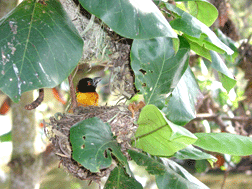 After
everyone returned from the park we ate breakfast at Han’s Cottage Botel.
Our breakfast conversation was difficult because of the din in the nearby
trees. Dozens and dozens of weaver birds were busy making their nests. These
are amazing little birds. They first find a long strip of grass and then,
using their beaks, they weave the grass into the previous piece of grass—building
their nest one piece at a time. They are careful to wrap each piece of grass
around a tree branch to ensure it doesn’t fall. At the hotel we identified
colonies of village, golden and Viellot’s black weavers.
After
everyone returned from the park we ate breakfast at Han’s Cottage Botel.
Our breakfast conversation was difficult because of the din in the nearby
trees. Dozens and dozens of weaver birds were busy making their nests. These
are amazing little birds. They first find a long strip of grass and then,
using their beaks, they weave the grass into the previous piece of grass—building
their nest one piece at a time. They are careful to wrap each piece of grass
around a tree branch to ensure it doesn’t fall. At the hotel we identified
colonies of village, golden and Viellot’s black weavers.
The Canopy Walk
 After
breakfast we went back to the park for the Canopy Walk. Stepping out onto
the first bridge your stomach turns a bit. Unless you love heights, it just
isn’t natural to walk between trees 40 meters above the forest floor. It
is a matter of faith that all will go well once you get out on the bridge.
After
breakfast we went back to the park for the Canopy Walk. Stepping out onto
the first bridge your stomach turns a bit. Unless you love heights, it just
isn’t natural to walk between trees 40 meters above the forest floor. It
is a matter of faith that all will go well once you get out on the bridge.
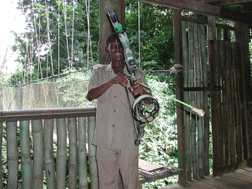
The Canopy Walk consists of seven bridges of varying lengths connected by platforms built around very large trees. Our guide “Still Alive” demonstrated how the bridges are built and repaired. A long bow is used to shoot an arrow with a thin piece of rope strung through it to a nearby tree. The archer aims the bow high into the target tree and releases the arrow pulling the rope with it. The nets around the bridge planking are replaced every four months to ensure that the bridges are safe. There are only a handful of these canopy walks in the world today. Looking out over the top of the forest one gets a brief window into the life of a monkey and other animals that spend their lives in the treetops.
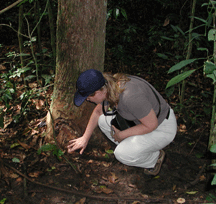 Our
guide stopped often to point out many of the trees we encountered along
the trail on the way to the Canopy Walk and to describe how the people of
Ghana use the trees for everything from medicine to clothing to dye to tools
for cleaning their teeth and cooking. The bark of another particular tree
was used for clothing before people here had access to cloth. A section
of the bark was peeled off and pounded until soft and three times its original
size. The "tree cloth" could then be used as a wrap.
Our
guide stopped often to point out many of the trees we encountered along
the trail on the way to the Canopy Walk and to describe how the people of
Ghana use the trees for everything from medicine to clothing to dye to tools
for cleaning their teeth and cooking. The bark of another particular tree
was used for clothing before people here had access to cloth. A section
of the bark was peeled off and pounded until soft and three times its original
size. The "tree cloth" could then be used as a wrap.
Small celtis trees are used as the pestle for pounding the fufu that is eaten here. Fufu is a favorite dish of Ghanaians. It is made of boiled cassava and boiled plantains. Then it is pounded into a gooey ball and served in soup. This food like most of the food in Ghana is eaten with your hands.
Cape Coast
Next stop, Cape Coast, where we ate lunch and then toured the Cape Coast Castle. The building of this castle started in 1637 and continued to recent times when it was renovated to become a memorial and tourist site. The reason so many visit this particular castle is because it was used as a slave holding area from the 17th through the 19th centuries when slavery was legal in many parts of the world. There are three dungeons where men and women were held before being put on ships and taken to the Caribbean, the Bahamas, or the United States and sold as slaves.
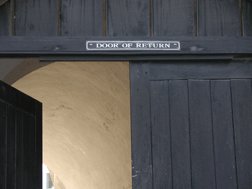 Next
to one of the dungeons is a doorway with the words “Door of No Return” leading
to the waiting ships. Recently, ancestors of people who walked through that
door into slavery returned and walked through this same doorway making it
the “Door of Return.” There aren’t too many places where one can stand on
this earth and feel such a powerful history of human suffering.
Next
to one of the dungeons is a doorway with the words “Door of No Return” leading
to the waiting ships. Recently, ancestors of people who walked through that
door into slavery returned and walked through this same doorway making it
the “Door of Return.” There aren’t too many places where one can stand on
this earth and feel such a powerful history of human suffering.
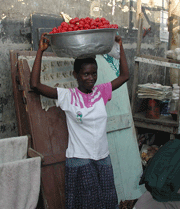 Leaving
the stark reality of the past and entering into the colorful reality of
the present, we went to the Cape Coast market to purchase food for our time
in Ankasa. At the market we bought rice, beans, fruit, spices and other
necessities. From now on we will be cooking our own food. Good thing that
Michael is a chef in real life.
Leaving
the stark reality of the past and entering into the colorful reality of
the present, we went to the Cape Coast market to purchase food for our time
in Ankasa. At the market we bought rice, beans, fruit, spices and other
necessities. From now on we will be cooking our own food. Good thing that
Michael is a chef in real life.
Driving In Ghana
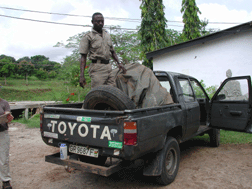 George
is a great driver. Being a great driver in Ghana requires a great deal of
skill. Drivers must negotiate all the potholes in the road while missing
oncoming traffic at the same time. More than once we have closed our eyes
while George swerved to the left to miss holes large enough to do substantial
damage to the tires. Just when it looked like we were about to hit the bus
that was heading straight at us, he deftly turned the wheel sharply to the
right and we were safely back in our own lane—that is, until the next
time. What appears to have been an extremely close call, and would normally
give us reason to pause, is just part of every day driving in Ghana. George
doesn’t even bat an eye.
George
is a great driver. Being a great driver in Ghana requires a great deal of
skill. Drivers must negotiate all the potholes in the road while missing
oncoming traffic at the same time. More than once we have closed our eyes
while George swerved to the left to miss holes large enough to do substantial
damage to the tires. Just when it looked like we were about to hit the bus
that was heading straight at us, he deftly turned the wheel sharply to the
right and we were safely back in our own lane—that is, until the next
time. What appears to have been an extremely close call, and would normally
give us reason to pause, is just part of every day driving in Ghana. George
doesn’t even bat an eye.
At midnight, after an infinite number of stops along the way to “state our mission” we drove into Ankasa….our home for the next 10 days.
Click here for the next day's highlights!